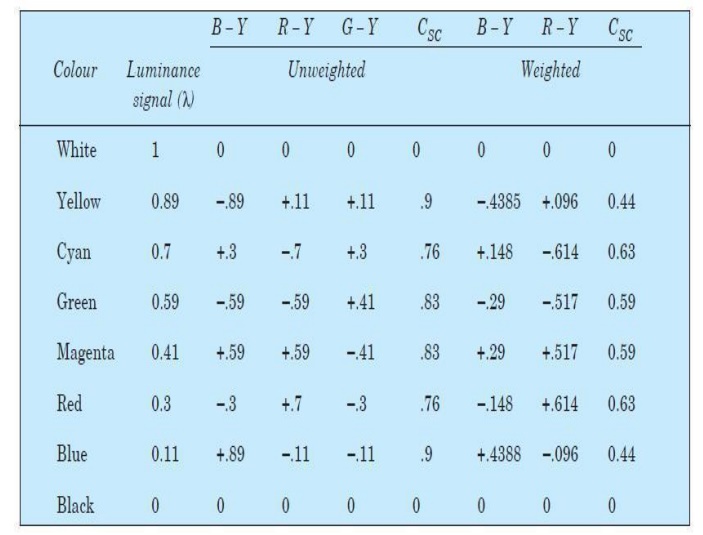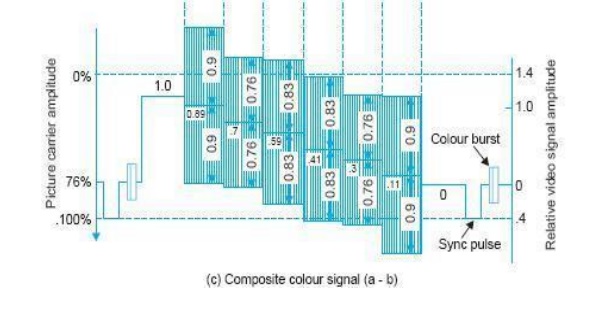Chapter: Television and Video Engineering : Essentials of Color Television
Weighting Factors
WEIGHTING FACTORS
The resultant chrominance signal phasor (C) is added to the luminance signal (Y) before modulating it with the channel carrier for transmission. The amplitude, i.e., level line of Y signal becomes the zero line for this purpose.
Such an
addition is illustrated in Fig. for a theoretical 100 percent saturated, 100
percent amplitude color bar signal. The peak-to-peak amplitude of green signal
(± 0.83) gets added to the corresponding luminance amplitude of 0.59.
For the
red signal the chrominance amplitude of ± 0.76 adds to its brightness of
0.3.Similarly other colors add to their corresponding luminance values to form
the chroma signal.
However,
observe that it is not practicable to transmit this chroma waveform because the
signal peaks would exceed the limits of 100 percent modulation. This means that
on modulation with the picture carrier some of the color signal amplitudes
would exceed the limits of maximum sync tips on one side and white level on the
other.
For
example, in the case of magenta signal, the chrominance value of ± 0.83 when
added to its luminance amplitude of 0.41 exceeds the limits of 100 percent
modulation of both white and black levels.
Similarly
blue signal amplitude greatly exceeds the black level and will cause a high
degree of over modulation. If over modulation is permitted the reproduced
colors will get objectionably distorted.
Therefore,
to avoid over modulation on 100 percent saturation color values, it is
necessary to reduce the amplitude of color difference video signal before
modulating them with the color subcarrier. Accordingly, both (R–Y) and (B–Y)
components of the color video signal are scaled down by multiplying them with
what are known as ‘weighting factors’.
Those
used are 0.877 for the (R–Y) component and 0.493 for the (B–Y) component. The
compensated values are obtained by using potentiometers at the outputs of (R–Y)
and (B–Y) adders (see Fig.).
Note that
no reduction is made in the amplitude of Y signal. It may also be noted that
since the transmitter radiates weighted chrominance signal values, these must
be increased to the uncompensated values at the color TV receiver for proper
reproduction of different hues.
This is
carried out by adjusting gains of the color difference signal amplifiers. The
un weighted and weighted values of color difference signals are given below in
Table.




Generation
of composite color signal for a theoretical 100% saturated, 100% amplitude
color bar signal. As seen from the relative amplitude scales, the composite
video signal would cause gross over-modulation. Therefore in practice the color
difference signals are reduced in amplitude to avoid any excessive
over-modulation
Related Topics